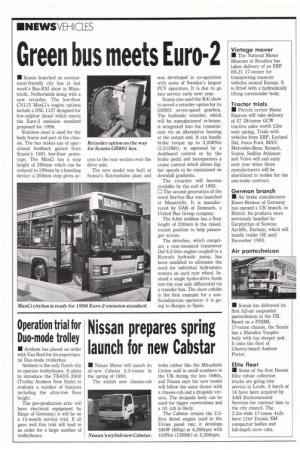Green bus meets Euro-2
Page 10

If you've noticed an error in this article please click here to report it so we can fix it.
• Scania launched an environment-friendly city bus at last week's Bus-RAI show in Maastricht, Netherlands along with a new retarder. The low-floor CN113 MaxCi's engine options include a DSC 1127 designed for low-sulphur diesel which meets the Euro-2 emission standard proposed for 1996.
Stainless steel is used for the body frame and part of the chassis. The bus makes use of operational feedback gained from Scania's 1991 low-floor prototype. The MaxCi has a step height of 350mm which can be reduced to 190mm by a kneeling device: a 200mm step gives ac cess to the rear section over the drive axle.
The new model was built at Scania's Katrineholm plant and was developed in co-operation with some of Sweden's largest PCV operators. It is due to go into service early next year.
Scania also used the RAI show to unveil a retarder option for its GR801 seven-speed gearbox. The hydraulic retarder, which will be manufactured in-house, is integrated into the transmission via an alternative housing at the output end. It can handle brake torque up to 3,000Nm (2,2121bft), is operated by a dashboard control or by the brake pedal and incorporates a cruise control which allows higher speeds to be maintained on downhill gradients.
The retarder will become available by the end of 1993.
The second generation of the novel Service Bus was launched at Maastricht. It is manufactured by DAB of Denmark, a United Bus Group company.
The 8.6m midibus has a floor height of 230mm in the raised, transit position to help passenger access.
The driveline, which comprises a rear-mounted transverse Daf 6.2-litre engine coupled to a Rexroth hydraulic pump, has been modified to eliminate the need for individual hydrostatic motors on each rear wheel. Instead a single hydro-drive feeds into the rear axle differential via a transfer box. The show exhibit is the first example for a nonScandinavian operator: it is going to Burgos in Spain.












































































